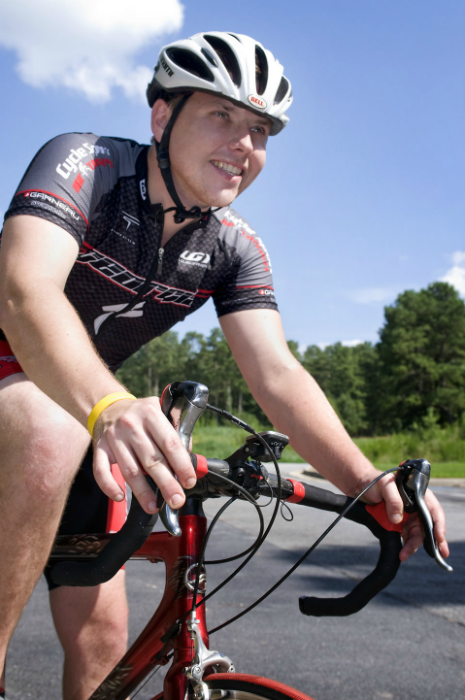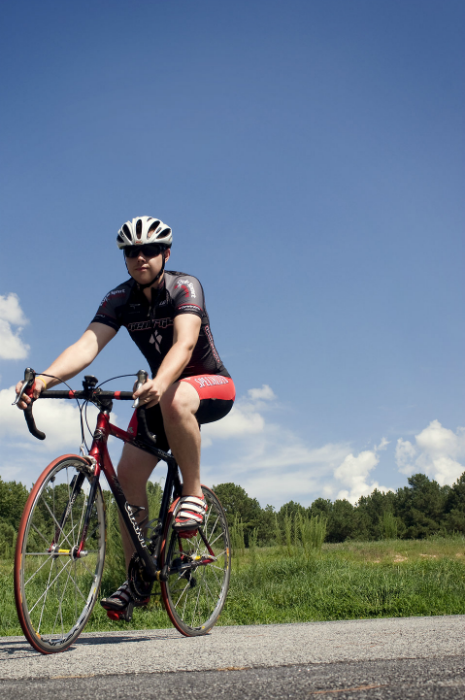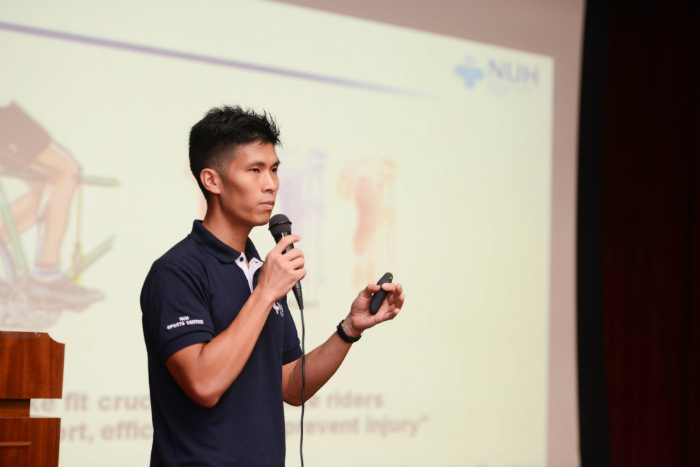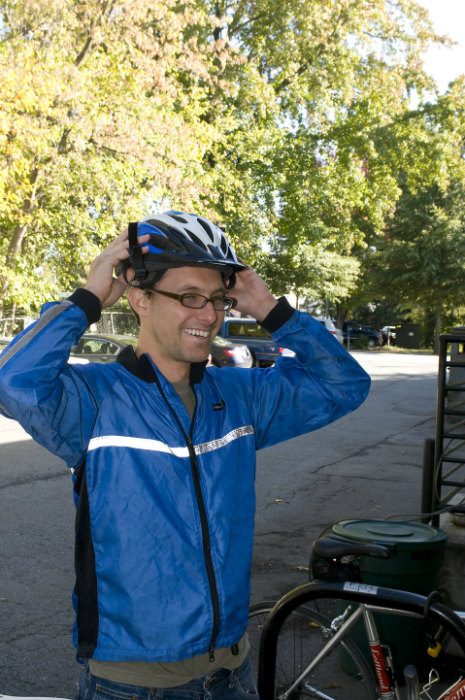Recently, OCBC Cycle Singapore conducted a series of talks on injury prevention and management for participants of OCBC Cycle, which takes place on 1 and 2 October.
One of the main topics discussed, had been about cycling injuries. Speakers from the National University Hospital (NUH) Sports Centre, shared more about overuse injuries and acute injuries, as well as how to prevent these.

The team from National University Hospital Sports Centre at the injury prevention and management talk at NUH. (Photo Credit: OCBC Cycle 2016)
Said Dr Wang MingChang, “As a sport, cycling generally has less impact than running on the body. But cycling is associated with a unique set of injuries, namely trauma and overuse injuries.”
In fact, Dr Wang pointed out that 62 per cent of elites and 85 per cent of recreational cyclists suffer from overuse injuries.
Added the doctor, “Overuse injuries happen because of the stress to our soft tissues, which connect the skin, tendons, joints and nerves. But the body recovers from the breakdown and heals to a stronger state where it will be able to withstand more stress.”
He continued, “But cycle too much too soon, and the breakdown occurs at a faster rate than the body is able to heal. This causes overuse injuries.”
Common injury areas in cyclists
Common areas where overuse injuries can occur are the:
Neck and Lower Back
Said Dr Wang, “The aerodynamic position puts stress on the neck and lower back joints so this can lead to neck and lower back pains.”
He added, “To prevent this, the simplest thing to do is to raise the saddle so that it tilts upwards, making you sit upright and your back also won’t be so bent forward.”

Cyclists can suffer overuse injuries if they are not careful.
Photo Source: CDC/ Amanda Mills acquired from Public Health Image Library (Website)
Hands and Wrist
Said Dr Wang, “Prolonged gripping of the handlebars can result in nerves being pressed upon, so you may get a numb or tingling sensation.”
He added, “This can be solved by raising the bike handlebars, so that the wrist is in a relaxed position. This will put less pressure on the nerves. Some cyclists may also choose to wear padded gloves to achieve the same effect.”
Buttock and Groin
Explained Dr Wang, “The repetitive rubbing of the buttock on the bike seat leads to ulcers. If it is not treated at the first sign of infection, this can lead to painful sores that require medical treatment and antibiotics.”
He continued, “But this can be prevented by wearing chamois padding to create an extra layer between the buttock and the seat. A more cushioned saddle can also reduce friction in the buttock area.”
Nerves and Blood Vessels
Said Dr Wang, “The nerves and blood vessels at the hip bone will get irritated and they will compress if you sit on the bike seat for too long – this causes a burning pain sensation that takes time to settle. The reduced blood flow to the genitalia may also lead to erectile dysfunction in cyclists.”
He added, “To reduce the pressure though, you can alternate between standing and sitting on the bike for long rides or take frequent breaks in between so that you are not seated all the time.”

The constant rubbing of the buttock on the bike seat can lead to ulcers.
(Photo Source: CDC/ Amanda Mills acquired from Public Health Image Library (Website))
ITB Syndrome
Explained Dr Wang, “The Iliotibial Band (ITB) rubs against the outside of the knee when the cyclist is in action.”
The ITB is the ligament that runs down the outside of the thigh from the hip to the shin.
Said the doctor, “When cyclists increase the intensity of their rides too much, this causes tight ITB muscles on the outside of the thigh and this causes increased friction, in turn, increasing pressure on the ITB and contributing to pain.”
To treat this injury, Dr Wang recommended that cyclists should reduce their training volume. He added, “Also pointing the toes forward rather than inwards when you are on the bike, also helps.”
Patellofemoral Pain Syndrome
Said Dr Wang, “This is pain in the front of the knee and it is caused when the knee cap rubs against the thigh bone.”
He added, “Having the bike seat too low, is a common cause for this as it will put added pressure on the knee. Weak or tight thighs or quads will also predispose you to this overuse injury.”
To treat this, Dr Wang recommended that the seat height should be raised. He said, “You should raise the seat height to reduce pain, and strengthen your core muscles.”
Foot Pain or Numbness
Said Dr Wang, “Such pain usually happens due to irritation of the nerves and tissues on the front of the foot. An incorrect shoe position and lack of cushioned insoles are common causes.”
He added, “To treat this, it is best to align the ball of the foot with the pedals spindle – this has been shown to reduce stress when cycling. Also, use cushioned soles as this reduces pressure and increases comfort during rides. Those with tight shoes should also loosen their straps to avoid irritation of the nerves and soft tissues in the foot.”
Stretching
Stretching regularly prior to and after bike rides, according to NUH physiotherapist Jeremy Mok, will help to keep cycling injuries at bay.

Mr Jeremy Mok shares more about choosing the right shoes and the various ways to look after one’s feet. (Photo Credit: OCBC Cycle 2016)
He said, “Start with dynamic stretches to warm up and prepare the muscles for the ride ahead. Longer warmup sessions can include 5 – 10 minutes of fast pedalling warmup. If you stretch 3 to 5 times weekly, in addition to your pre-ride stretches, this should help.”
Continued Mok, “Stretching should mean that there is discomfort but no pain.”
Mok particularly recommends calf stretches against a wall or hamstring stretches – because he says that the hamstrings are tight in most cyclists and this affects the pelvic movements when riding.
Other areas to focus on, will include the quads. Said Mok, “We are sitting down at work, and when we cycle we often spend 2 – 3 hours per ride. The act of sitting causes tightness in front of the high and inhibits the glutes.”
Some exercises include goblet squats, normal squats and single legged deadlifts. Added Mok, “When squatting, make sure that the knees do not cross over the toes.”
“And of course, listen to your body at all times,” the physiotherapist continued.
Acute cycling injuries
Besides overuse injuries, another category of injuries that a cyclist can be prone to, are acute injuries which are typically caused by accidents, according to Dr Francis Wong from the NUH Sports Centre.
Said Dr Wong, “75 per cent of fatal cycling accidents occur in urban areas. These can include motorists turning into the path of cyclists, or cyclists riding in the path of motor vehicles.”
Dr Wong also points out that wearing a helmet can reduce the severity of injuries by 85 per cent, especially those pertaining to the head. He said, “The helmets are adequately placed for protection especially when cyclists fall and land on their shoulder or head.”

Wearing a helmet reduces the risk of acute cycling injuries by up to 85 per cent.
Photo Source: CDC/ Amanda Mills acquired from Public Health Image Library (Website)
Sometimes, injuries can involve surgery, such as bone dislocations and fractures. Said Dr Wong, “Sometimes the bone may be exposed and surgery is needed to screw it back into place.”
But mostly though, those who fall off their bikes usually get abrasions and superficial cuts which can easily be treated with topical medications. Said the doctor, “These include lacerations and bruises which are treated easily.”
After such injuries though, especially the more serious ones, it may be trying, both physically and mentally, for the cyclist to get back onto the bike, thus doing so requires both time and patience to return again to the sport.

Leave a Comment